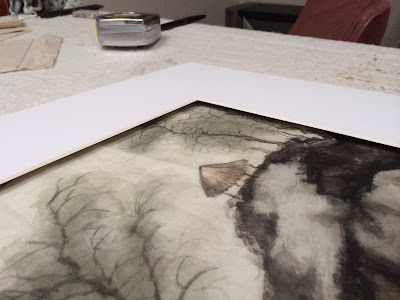These seemingly casual encounters actually help to form the basis of a non-analytical analysis. What an oxymoron! What I meant is that I started to feel instinctively something is good or bad, and that motivates me to pry into the causes for my concerns.
I felt that something is amiss.
Well let me see what is good first.
I liked the effect of the white margins left by the alum solution. As I said before, my inclination to use alum is probably due to my inadequacy in my brush strokes, my Gi Bun Gong, and my lack of control of the proper amount of water. A good painting is a successful interplay of ink, water, paper and brush. I have used different types of Xuan paper. Aside from different absorbency and tendency to bleed, some will retain a more distinctive margin in between brush strokes. Since I am not a connoisseur of Xuan or ink, I only had the pleasure of chance encounters with said products. I do not know enough to seek out a particular type or brand to acquire.
Anyways I was able to portray the apparent feel of tendons and muscles by giving them definition with white margins in the following example:
The white margins left by alum also helped to add layer and depth in the hairs of the mane and tail:
And of course I love the body language of the horse, enough to name it joie de vivre. What gives this painting a sour taste is the neck area of the horse.
I suppose the painting of animals do require a certain understanding of anatomy. In this particular case the strong neck muscles needed to control that long cervical spine is totally missing in the representation. What I have depicted is almost like kids playing with sand on the beach, trying to build a sand horse. Bucketfuls of sand is piled on top of the chest to depict the neck, without regards to how the neck should be attached for articulation. What I have erected was a column that I called a neck and placed it on top of the body, without accounting for how this column should be rested on the shoulders. Hence begging the question, should anatomical proportions and placements be exact when doing Chinese brush painting? According to 6 doctrines prescribed by Xie He (謝赫 )likeliness only assumed the number 3 position of relative importance. Can I write off this miscalculation by saying brush strokes trump proper anatomy? I don't know. I wish I know!
From the painting, we can see the white margin left by the original brush stroke of the neck.
In subsequent shading and augmenting the lines, I had changed the contour of the neck column.
This is the result after digitally erasing the extraneous brush strokes outside of the white margin to shape the neck better. Does this alteration render a better fit for the neck to the shoulders?





























